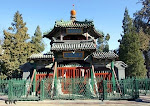It's actually the idea of how some degree of artistic flair makes its way into religion that really strikes me as pretty amazing. Not just with writing in the calligraphic form, but also architecture - most notably with the design and beautification of Chinese mosques. Like calligraphy, the architecture style lying behind the mosques is a perfect example of the melding together of two different cultures, incorporated into one being. Chinese mosques and 'traditional' Arabian-styled mosques are very distinct from each other and easy to tell apart. The background cultural influence of the area's culture is evident from the style that it is built upon
The mosque, upon first glance looks very 'Chinese' - that is, it is able to easily blend itself with the surrounding environment among the distinctly Chinese-styled buildings. And yet it's a brilliant example of the coming together of different cultural influences to create a a meeting point between two very different worlds.
Compare the above mosque with the more 'common' Arabian-styled mosques and the overt influence of Chinese culture can be easily seen. I think it's great to see the acculturation of different cultures blending in together to create something new. Additionally, it'd make it much easier for Muslim societies in China to blend in with the rest of society - especially since they would be considered a minority group against the majority Han-Chinese people.
The same thing can be said about calligraphy. This may not be completely correct, but I like to think that there is some degree of 'commonality' between Arabic scripts and Chinese scripts, mainly in the manner by which it is written. Both Arabic and Chinese characters appear to me as more artistic words, rather than plain written texts. The English alphabet on its own looks rather simple and straight forward, whereas I like to see Chinese and Arabic written texts as something far more appealing to the eyes.
Going back to the idea of mosques and the architecture, Chinese mosques are, like traditional Arabian-styled mosques, have their interior and exteriors decorated with calligraphic pieces of work.
Again, the influences of both cultures can be seen coming together to create a single, united piece of writing. Clearly Chinese by the manner and materials used to write it, yet with that noticeable blend of Arabian calligraphy worked into it.
The same thing can be said about calligraphy. This may not be completely correct, but I like to think that there is some degree of 'commonality' between Arabic scripts and Chinese scripts, mainly in the manner by which it is written. Both Arabic and Chinese characters appear to me as more artistic words, rather than plain written texts. The English alphabet on its own looks rather simple and straight forward, whereas I like to see Chinese and Arabic written texts as something far more appealing to the eyes.
Going back to the idea of mosques and the architecture, Chinese mosques are, like traditional Arabian-styled mosques, have their interior and exteriors decorated with calligraphic pieces of work.
Again, the influences of both cultures can be seen coming together to create a single, united piece of writing. Clearly Chinese by the manner and materials used to write it, yet with that noticeable blend of Arabian calligraphy worked into it.











